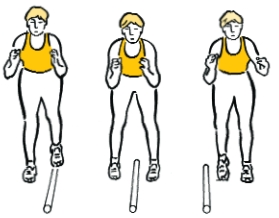Athletic Drill Bits

Is your latest class or client program in need of renovation? Introduce athletic
movements that are simple, powerful and drill-based. Help participants improve their speed, agility, balance and muscle definition with an uncomplicated format that is easy to instruct and suitable for all fitness levels.
Although Drill Bits is a group fitness class, the exercises can easily be implemented in personal training programs, in both one-on-one and group sessions. Piece together an endless array of drills by using common studio equipment and an inspired vision. Participants will not only get a great workout but also feel like superstar athletes.
Aim at accomplishing three main
objectives:
- Create a series of 2-minute drills that challenge aerobic capacity.
- Design a “toolbox” full of equipment that enables participants to work effectively and efficiently.
- Use level options (hard, harder, hardest) that allow multiple fitness levels to work side by side.
Think simple, effective and fun when planning drills. Your main goal is to provide a great total-body workout. If complex choreography enters your mind, refocus on the athletic aspect of the drills.
To get started, write down all the basic athletic moves you can think of. Your list might read:
- run
- jog
- shuffle
- throw
- retrieve
- jump
Next formulate athletic drills using variations of these base moves. For example, turn a basic jog into a quick football run, a stationary high-knee run, or a moving run that challenges participants’ abilities to stop and start at marked stations.
After you have a list, integrate the equipment. See “Sample Drill Sheet” for an
example of how to do this.
The possibilities and combinations are endless, so keep your drills in a “drill log.” One drill often sparks another and then another. You’re limited only by your imagination. Keep the workout safe and, most important, drill-based.
Now create your toolbox. Take a few minutes to mentally inventory the equipment in your facility. What do you have and how can you use it? Choose the Step™, Body Bar™, tubing, stability ball, medicine ball, jump rope—almost any piece of equipment will work. A caveat: Choose gear that allows participants to work effectively, efficiently and unimpeded. Don’t use any equipment that is too big, bulky or heavy to move quickly. All equipment should be placed in a central storage area that allows users to easily access any piece at any given time.
Don’t feel limited by lack of supplies. It doesn’t matter if your studio is empty or stocked with all the latest fitness equipment. Mix and match what you have. If you don’t have agility cones but want to do a lateral shuffling drill, use Step risers instead.
Look at what you could do with just a simple piece of chalk: Set up team relay races in which participants run to a marked spot, write their name on the ground and then sprint back to hand off the chalk to the next runners. Be creative; it’s not what you have but how you use it. Frequently change your toolbox. Varying equipment keeps participants interested and makes the drills fresh and exciting.
Take a look outside your facility for more ideas. Stairs, outside decks, running trails, grassy hills, parking lots—use them all. Run the stairs; sprint down the hills; shuffle down a marked line in the parking lot; hit the outside deck for a set of jumping jacks and push-ups. Change the routine to keep it interesting. The simple athletic movements that power Drill Bits also make it very portable.
Once you have decided which drills and tools you will use, weave them together to create a seamless class. Imagine that participants form a construction crew and there is little downtime as the crew breaks down one drill set and quickly builds another. Clearly instruct participants on equipment and drills, then set everything up and get moving. Use movement patterns that facilitate quick transitions and also allow for equipment changes. For example, follow a Body Bar quick step with a Body Bar chest press on the Step. The second drill incorporates the Step and allows the participant to quickly grab the bar off the floor and use it.
To give all fitness levels a chance to succeed, offer “hard,” “harder” and “hardest”
options. A new participant will think, “Wow, I’m working hard and I can do it!” Here’s how to apply level options to a specific move:
Base Move: Step-Touch
Hard: Step-touch low and wide on the floor.
Harder: Change the step-touch to a power hop from side to side.
Hardest: Using the Body Bar as a length marker, leap from side to side as you strive to go past the end of the bar.
Athletic drills awaken the track star in the sleeping couch potato. Empower participants and clients to explore different movement options and challenge them to excel on many different levels. Simple, powerful movements are the key. Put on your coaching cap and start designing drills that motivate and inspire.
One piece of equipment often works for numerous drills.
- Jump rope: Use in moving partner slalom work; as a barrier for skate-hops; as a tie for a three-legged race; and, of course, for jumping rope.
- Step risers: Use as a replacement for agility cones; stack for relay races and straddle-run football drills.
- Step: Create an ascending and descending staircase using risers; use as a target for plyometric leaps and as an agility marker for running and shuffling.
- Masking tape: Mark a start and finish line for speed and agility drills, or indicate a target for hops or lateral shuffling drills.

- Prepare participants for activity with a simple 6- to 8-minute warm-up. Walk around the room in a large circle and slowly increase the intensity to a power walk.
- Clearly review instructions before beginning drills.
- Make sure all participants understand the drills. If someone seems hesitant or frustrated, directly address her concerns.
- Immediately store all equipment after usage.
- Ensure participants properly cool down and stretch before leaving. Gradually bring the intensity down by decreasing the work effort. Start with a power walk and slowly transition to a normal walking pace.
BODY BAR QUICK STEP
Equipment Needed: Body Bar (any size)
Place Body Bar lengthwise in front of you on the floor. Stand to one side and step over the bar, performing a quick triple-step on the opposite side. Immediately go back over the bar and perform the quick triple-step again. Stay on the balls of the feet and focus on speed. Move over the barrier quickly and don’t stop the feet on either side.
Safety Cues: Keep eyes focused on the bar, and concentrate on clearing it to avoid tripping.
MEDICINE BALL PASS
Equipment Needed: 4-, 6- or 8-pound medicine ball
Partners stand approximately 6 to 8 feet away from each other, feet shoulder distance apart, knees bent in slight squat and hands in “ready” position. Partner #1 holds medicine ball at chest level, steps forward and releases the ball with force, aiming for partner #2’s chest. Receiving partner catches ball and returns the throw. Modify by increasing or decreasing the throwing distance.
Safety Cues: Advise partners to signal that they are ready to begin before the first throw.
LATERAL RISER SHUFFLE
Equipment Needed: two Step risers
Place two Step risers on the floor, approximately 6 feet apart. Stand behind one riser in “ready” position with feet shoulder distance apart, hands at chest level, knees bent in a slight squat. Shuffle laterally, crossing one leg behind the other and touching the far riser at the end of the movement. Shuffle back to the starting position and repeat. Modify by taking out the crossover touch for beginners, or increasing the distance between risers for advanced participants.
Saftey Cues: Use masking tape to indicate start and finish marks behind the risers.
EQUIPMENT SOURCES
SPRI Products, (800) 222-7774, www.spriproducts.com
Perform Better, (888) 556-7464, www.performbetter.com
Power Systems Inc. (800) 321-6975, www.power-systems.com
SUGGESTED READING
Brown, L., Ferrigno, V., & Santana, J.C. (Eds.). 2000. Training for Speed, Agility, and Quickness. Champaign, IL: Human Kinetics.
Dintiman, G., Ward, B., & Tellez, T. (Eds.). 2003. Sports Speed. Champaign, IL: Human Kinetics.
Foran, B. (Ed.). 2001. High-Performance Sports Conditioning. Champaign, IL: Human Kinetics.
Jennifer Renfroe
Jennifer Renfroe is the regional director of group fitness for Crunch Fitness┬« in Atlanta. She is also a master trainer for the Nautilus InstituteÔäó/Schwinn Cycling┬«. Certifications: ACE, AFAA






